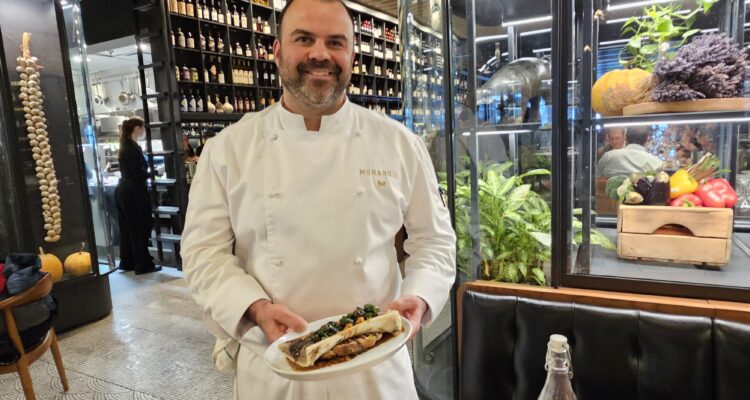Montréal is renowned as a city known for warm hospitality and outstanding food. All these elements come together during the biggest winter festival in Canada, Montréal en Lumière. The city “in light” reflects the excitement of 10 days of gourmet, cultural, and outdoor adventures. The festival concludes with the Nuit Blanche or White Night when the Metro never stops and activities abound until dawn.
My experience during the first three days of the festival evolved into an eye-opening, non-stop, gastronomic feast. The full festival featured lunches, dinners, teas, and brunches at over 60 Montreal restaurants, over 90 guest chefs, pastry chefs and winemakers representing 15 Michelin stars from eight countries.
What was noteworthy this year was the theme of women in food and wine in the gourmet track. At one of the lunches honoring women chefs and restaurateur leaders in the city, I spoke with Julie Martin, the manager of the culinary program at Montréal en Lumière who noted the gastronomic magic that has occurred since its inception in 2000.
“When guest chefs meet the host chef, it’s like an unrehearsed script. The experience is alive and animated. Beyond creating menus on paper, these chefs take over the host’s kitchens and as artists, present their identities and backgrounds on the plate,” said Martel.
We will review four of the starring Montréal restaurateurs and their celebrated female guest chefs at the festival. Sabayon, one of the restaurants highlighted, received a Michelin star after the festival in the first selection by Michelin in Montréal.
Le Monarque
At Le Monarque, I dined with one of the male chef-owners hosting an American celebrity chef who influenced his career. During the third Montréal en Lumière festival in 2002, Jérémie Bastien met Nancy Oakes, an acclaimed California chef, at his father’s restaurant. Preparing her memorable guest chef meals, Oakes established a bond with the Bastien family. Noting young cook Jérémie Bastien’ eagerness to learn. Oakes invited him to work for a year at Boulevard, the restaurant she owns in San Francisco.
This year Oakes returned to Montréal for the first time in 23 years to cook at Bastien’s restaurant, Le Monarque, which he opened in 2019. After the festival, Oakes shared her perspective with me on Monarque which features both a brasserie-inflected area and fine dining spaces: “It is a smart and beautiful place with a staff that cares about people. During the festival, I heard that Monarque may garner Michelin recognition.”
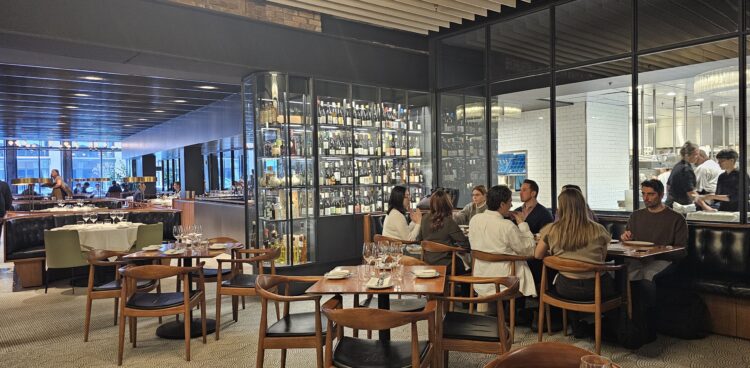
While sampling Bastien’s food during the festival, Bastien shared his excitement about hosting Oakes the following week. “I observed how well her brigade of cooks worked as a team to run a large restaurant. She taught me to never over-work the plate—let the primary ingredients shine,” said Bastien.
Bastien’s tuna tartar appetizer is an exceptional melding of the fish with foie gras custard, ponzu tapioca and cardamom. Oakes later told me the tuna tartare riffed off her Boulevard version. “But we cannot get foie gras in Calif., so his version was an excellent treat.”
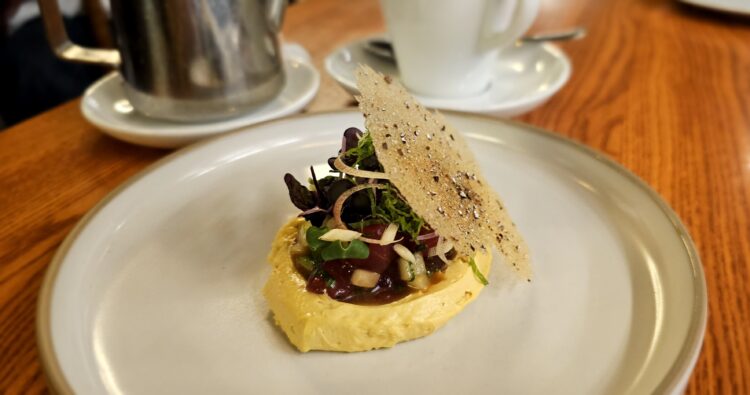
At Monarque, Bastien next brought an amazing surprise: bone marrow served with Burgundy snails, red wine jus and persillade. Like the tuna tartare, the dish was visually stunning and delicious. During Oakes festival dinner, a friend mentioned that I was writing about the festival and had sampled Bastien’s food. Oakes immediately responded, “I bet he served her the bone marrow.”
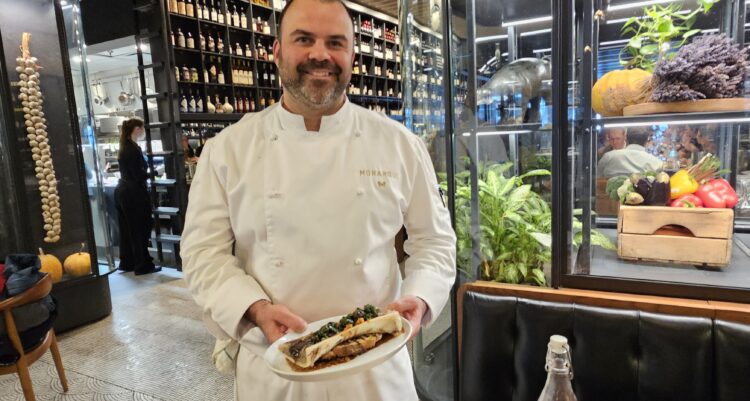
Bastien surprised me again with a sample of mango Pavlova. I responded, “It is a madeleine memory of Australia.” He smiled and said, yes, he had worked there and enjoyed Pavlovas. Moreover, he added, he left Montréal to travel and work in France, Asia, and Australia, where he met his wife and pastry chef.
“I named the restaurant Monarque because the butterfly travels a far distance from North America to Mexico to reproduce. The period when I traveled has enhanced my culinary palate and portfolio,” noted Bastien.
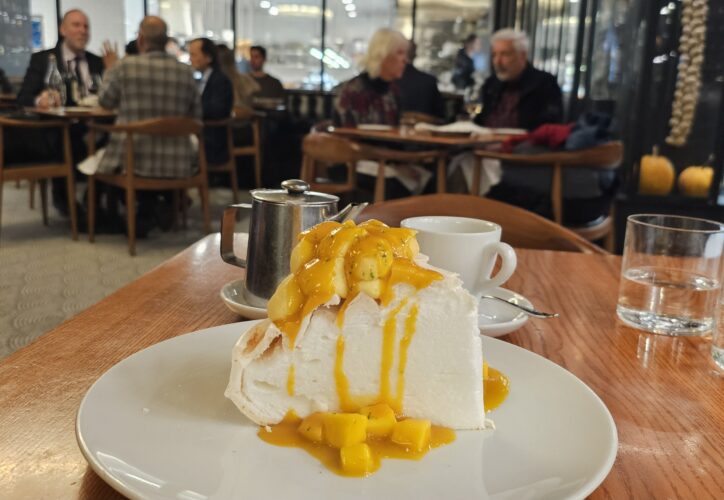
Ferreira Café
Though Montréal suggests French food, Ferreira Café is known, one patron told me, as the best Portuguese food outside of Portugal. Opened 20 years ago by her father Carlos, his daughter Sandra Ferriera now manages the restaurant and greeted me warmly. The bright Portuguese ceramics on the wall and display of fresh fish brought the flavor of the family’s native country closer to the guests.
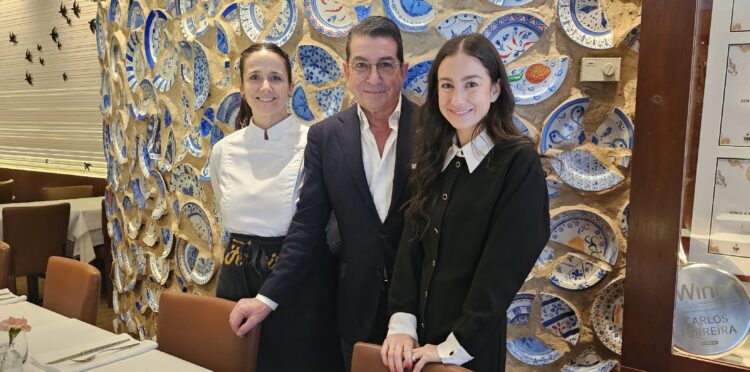
The two words to describe Sandra Ferreira are energy and insight. Active in La Table Ronde, the city’s restaurant association, Ferreira received a Women’s Leadership grant during the festival. She was quick to share the success of other women restaurateurs in the city and introduce me to her talented chef, Natalia Machado. I tasted Ferreira sardines, a signature dish, with local fleur de sel, roasted garlic and lemon purée beautifully splayed the plate.
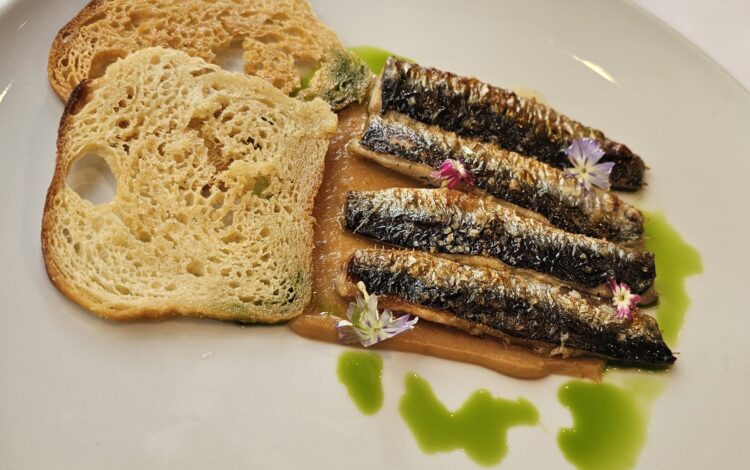
When Machado delivered a plate of crispy octopus, pickled onions, bean hummus and smoked paprika oil, I found the delicate seasoning and light touch in the sauté pan created better texture and flavor than I experienced in Porto.
Ferreira invited Sonia Bichet, a celebrated seafood chef and oyster shucker from France, as her festival guest. During my lunch visit, I sampled her cod with smoked tomatoes for the evening’s meal.
“Bichet named her festival menu, ‘The Story the Ocean Tells.’ Watching her in our kitchens is like a master class for fishmongers. The guest chefs indeed share a story about their cooking, and we learn from them,” said Sandra
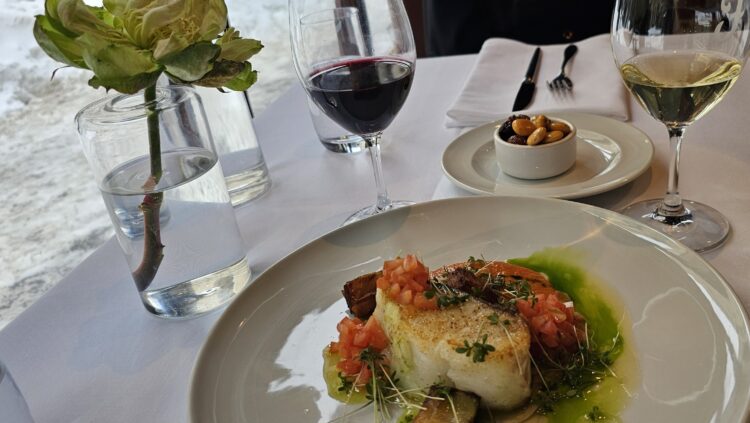
The Ferreira desserts included Portuguese tarts and a delicious chocolate mousse with a fleur de sel (salted) caramel ice cream with a tuile of honey from the Azores with a dusting of cocoa powder.
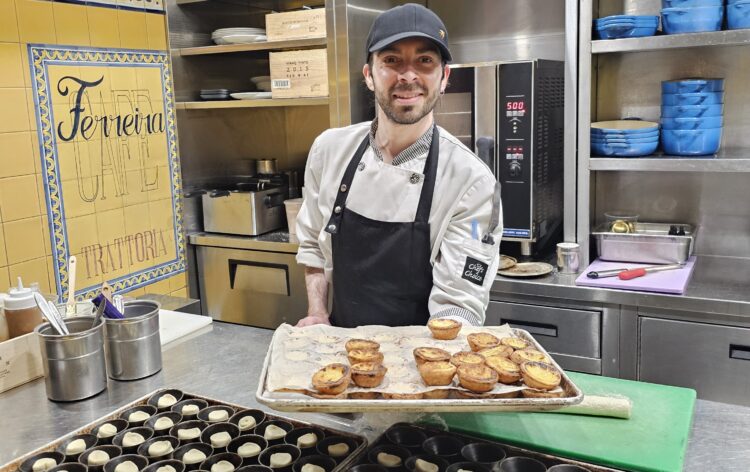
Ratafia Wine Bar
Though labeled as a wine bar, Ratafia is a gourmet eatery in the Little Italy neighborhood. The vibe reminded me of fern bars in the U.S. during the 1970s, a cozy, welcoming bars with abundant greenery and other natural, homey touches. Ratafia adds refinement with several art deco touches.
Ratafia owners Sandra Forcier and Jared Tuck met at culinary school and gained renown for their Ratafia pastries. A friend told me Ratafia has been the place where Montréalers order dessert after dinner. But the restaurant has evolved into a dining spot with food selections from the “salty” or “sweet” menus accompanying the well-curated wine and cocktail list.
During the festival, their guest chef, Maya Sittisuntorn of Marble Desserts in New York City, performed culinary magic during her two courses for the dinner. After following Sittisuntorn in Instagram, Forcier was intrigued by her creativity and meld of Asian and Western cooking and invited her to the festival. Though the acclaimed Marble restaurant that Sittisuntorn and culinary partner owned closed, the duo turned to cooking for private clients.
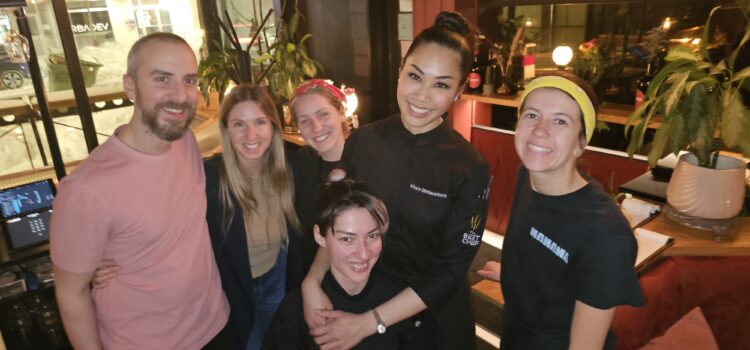
For the first course of the festival dinner, Sittisuntorn presented an alluring version on a well-known Thai soup. The chef described the Yom Kha starter as “carrot sorbet, lemongrass gelée, kefir line and lemongrass infused coconut soup, parsley oil and chili oil.” Served with a medium-bodied, slightly sweet German Riesling, the food and drink were a stunning pair.
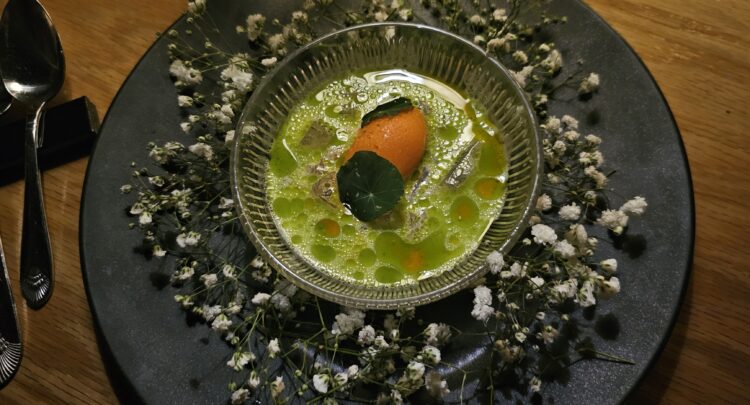
After a fish course of poached Québec halibut prepared by Tuck, I savored delicious cavatelli with buckwheat chili crisp, buckwheat honey gastrique and dill.
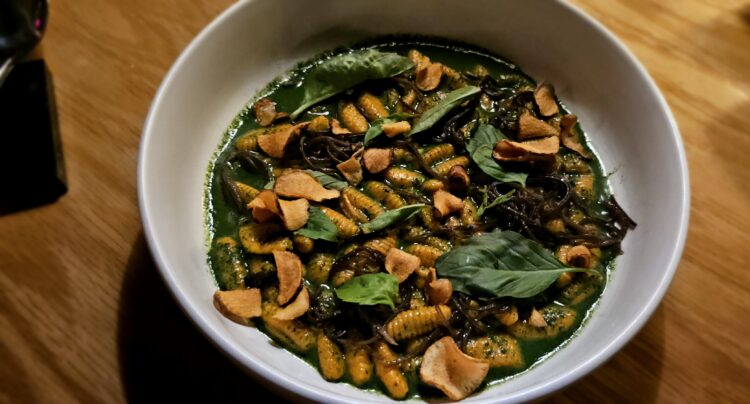
Sittisuntorn dessert transformed a classic dessert of strawberries and cream into a vegan creation of buckwheat tea (soba cha) instead of dairy and Perigord truffles instead of fruit.
“The simplest things are often the hardest to make perfectly.” said Sittisuntorn. “In transforming a classic dish into your style, you cannot go crazy. Take this dessert. Here we simply pair the vegan ‘cream’ with truffle and add chocolate mousse.”
Sabayon
Another example of adding a savory menu to renowned pastry experience manifests at Sabayon, another Michelin star-candidate in the Pointe-Saint-Charles neighborhood of Montréal.
I felt instantly at home in their brightly decorated, 14-seat restaurant after a warm greeting by owners Patrice Demers and Marie-Josée Beaudoin.

An award-winning pastry chef and author, Demers is a celebrity chef in Canada and beyond, and after the festival in May, 2025. Sabayon received a star from the Michelin Guide in their first announcement of winners in Montréal.
For twelve years, he owned Sabayon as a pastry shop in another part of the city. The couple then closed the shop and traveled widely. After a stint collaborating with another celebrity chef, Marc-André Jetté, co-owner of Montréal restaurants including Annette, Demers opened the current Sabayon in 2024 to serve acclaimed, locally sourced dinners three nights a week.
During a morning interview with Demers, the chef shared delicious Sabayon financier pastries made with local buckwheat flour and maple sugar.

Though I was unable to attend the festival dinner with Michelin-starred chefs from Datil restaurant in Paris, I met the owners, Manon Fleury and Laurène Barjhoux.
“Datil is so renowned in Montréal that tickets for their dinners sold out in one day,” said Beaudoin. Fleury and Barjhoux were thrilled to visit Montréal for the first time and cook at Sabayon. “This opportunity to guest chef during the festival was the first time we have taken a break since founding Datil in 2024,” said Fleury.
While Demers and Beaudoin were celebrating their receipt of a Michelin star, I dined at Datil in Paris. The chefs paused a moment during service of the six-course lunch for a photo. The food applauded natural ingredients cooked to perfection.
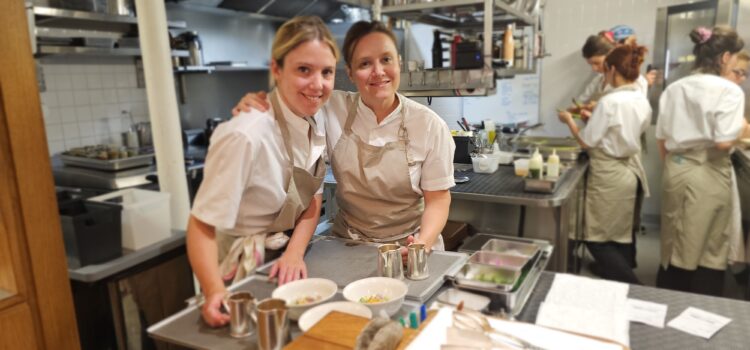
Among the chefs’ five-course dinner in Monrtéal, Beaudoin was eager to describe their grilled mushroom and sabayon course that she paired with Arianna Occhipinto’s Frappato at their dinner. “The skewers of local shiitake mushrooms are like magic because they add a savory sabayon sauce made with quince reduction and local pancetta,” said Beaudoin. The savory sabayon sauce is a nod to their hosts’ specialty, the French dessert sauce made with egg yolks, sugar, and wine.
The diversity of experiences with food, drink, and hospitality is exceptional in Montréal during a regular visit. The opportunity to explore the city, dine with top chefs in the city—and meeting up with creative international chefs—will warm the hearts of those seeking gastronomic adventures.
Photo credit to the author

